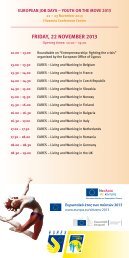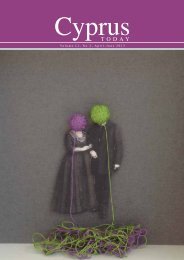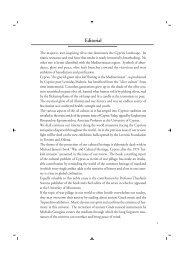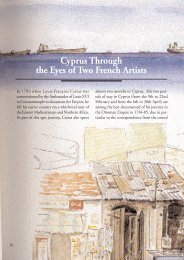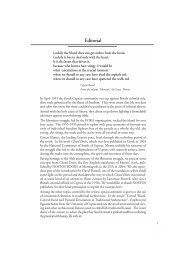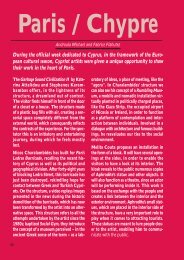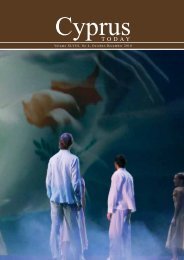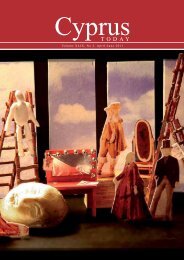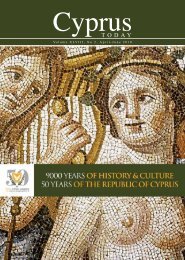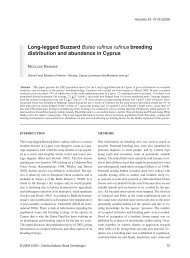Cyprus Today, Jan-March 2007.pdf 1-27
Cyprus Today, Jan-March 2007.pdf 1-27
Cyprus Today, Jan-March 2007.pdf 1-27
You also want an ePaper? Increase the reach of your titles
YUMPU automatically turns print PDFs into web optimized ePapers that Google loves.
Editorial<br />
Nicosia, the capital of <strong>Cyprus</strong> is the place which has been continuously inhabited<br />
for the longest time on the whole island. It can boast an almost uninterrupted<br />
succession of settlements from the Chalcolithic period in the 4th millennium<br />
BC to the present day.<br />
Modern Nicosia is built on layers of ruins, the typical stratigraphy being - from<br />
the lowest strata - Cypro-Archaic, Hellenistic, Byzantine, Frankish, Venetian,<br />
Ottoman a long succession of civilizations. It is not surprising, therefore,<br />
that many construction sites in Nicosia may turn out to be archaeological areas<br />
the earth yielding up its secrets as archaeologists painstakingly work to uncover<br />
the mysteries it held back for centuries.<br />
After St George’s Hill, where the discovery of part of the ancient city has put<br />
the project for a new House of Representatives building on hold (see relevant<br />
article by Dr Despo Pilides in <strong>Cyprus</strong> <strong>Today</strong>, vol. XXXVII, April - June<br />
1999), and the unearthing of a Lusignan castle in the heart of the old city<br />
where a new municipal building is to be erected, a new surprise was in store<br />
on the construction site of the new Supreme Court. The site, situated on the<br />
eastern bank of the Pedieos River revealed the ruins of a 14th century convent<br />
of the Cistercian Order.<br />
In the main article of the present issue of our review, archaeologist, Eftychia<br />
Zachariou-Kaila, whose team have been carrying out intensive excavations,<br />
presents their important findings which do not only identify an important<br />
monastery but also provide clues to the lifestyle of nuns living in Cistercian<br />
convents.<br />
In the same revelatory and exploratory spirit, Dr Sophocles Hadjisavvas, in his<br />
article “Wine Culture in <strong>Cyprus</strong>” presents the case of wine making on the<br />
island through the eyes of an archaeologist. The topic was well debated throughout<br />
the centuries. Historians, geographers and travellers often refer to the wines<br />
of <strong>Cyprus</strong>, for which the island has been renowned since antiquity, as being<br />
‘extremely subtle’ or ‘exquisitely light’. Pliny considers <strong>Cyprus</strong> wine to be superior<br />
to all other wines, while Strabo designates <strong>Cyprus</strong> as ‘an island of fine<br />
wines’. Mediaeval travellers never fail to praise the strong and rich wine of<br />
<strong>Cyprus</strong>. Although the beginning of wine making in <strong>Cyprus</strong> cannot be dated<br />
with certainty, Dr Sophocles Hadjisavva’s article reveals archaeological evidence<br />
which suggests that wine making was practiced long before Pliny’s or Strabo’s<br />
references. It is obvious that the roots of viticulture in <strong>Cyprus</strong> go back to<br />
the depths of history as the roots of our vines to the depths of our land.<br />
1
2<br />
The Cistercian<br />
Convent<br />
of St. Theodore<br />
in Nicosia<br />
Rescue Excavation in the Supreme Court Area<br />
The medieval fortification of Nicosia,<br />
as it developed before the 16th century,<br />
was made redundant with the arrival of<br />
gunpowder, which changed century old<br />
traditions of warfare. Guns and fortresses<br />
were now essential for defence.<br />
Due to the pressure of Ottoman expansionism<br />
that appeared as early as the 15th<br />
century, the old medieval fortifications<br />
Nicosia within the Venetian walls<br />
Eftychia Zachariou Kaila - Department of Antiquities<br />
that protected the cities of the Venetian<br />
empire needed to be modernized. Consequently,<br />
in 1567 the Venetian Crown<br />
began designing the new walls of Nicosia.<br />
The Venetian walls of Nicosia had a smaller<br />
circumference than the previous Lusignian<br />
walls. In order to achieve a better<br />
defence system it was thought necessary<br />
to demolish any building that lay in the<br />
area between the old and new walls. The<br />
ruins of these buildings became valuable<br />
sources of sandstone, which was<br />
the main material used for facing the new<br />
walls.<br />
Among the eight churches – both Orthodox<br />
and Catholic – and the five monasteries<br />
that were sacrificed in the name<br />
of defence, was the female monastery dedicated<br />
to St. Theodore, which belonged<br />
to the Latin Cistercian Order (Estienne
de Lusignian, Description de toute l’isle<br />
de Chypre, Paris, 1580, fol.32).<br />
In his important book on the Gothic<br />
Art in <strong>Cyprus</strong>, published in 1899, the<br />
French archaeologist Camille Enlart mentions<br />
St. Theodore, which was already<br />
known from written sources, as being one<br />
of Nicosia’s vanished monasteries and<br />
whose exact location was unknown.<br />
More than a century later, on the construction<br />
site of the new building of the<br />
Supreme Court and covering the area of<br />
the new building’s future monumental<br />
entrance, chance finds were unearthed which<br />
identified the site as the remains of the nunnery<br />
of St. Theodore.<br />
On the 30th of August 2004 the contracting<br />
company of the new Supreme Court building<br />
notified the Department of Antiquities<br />
that a tombstone had been unearthed<br />
during construction work. It was therefore<br />
necessary to thoroughly examine the<br />
area.<br />
3
4<br />
The inscribed tombstone unearthed during the<br />
construction of the new Supreme Court. The figure<br />
of the abbess, Plaisance de Giblet, who died in<br />
1328, is engraved on it<br />
The inscribed tombstone, which happens<br />
to be our most important find, enables us<br />
to link the architectural finds with the available<br />
historical enidence1 . In this context the<br />
female figure engraved on the tombstone<br />
holds a staff in her left hand, which symbolizes<br />
both the abbess’s power and her pastoral<br />
role. The figure is bordered by an<br />
inscription, which refers to Plaisance de<br />
Giblet, abbess of the nunnery of St. Theodore,<br />
who died on Friday, 10th of February 1328.<br />
In 1244 the head of the Cistercian Order,<br />
Abbot Boniface of Citeaux (the original and<br />
leading monastery of the Cistercian Order)<br />
gave his approval for the foundation of an<br />
abbey of nuns of the Cistercian order in<br />
Nicosia. This was with the initiative of Alice<br />
of Montbeliard, widow of the regent Philip<br />
of Ibelin, who wished to provide a place for<br />
her daughter Mary. The plot for this convent<br />
was located between the first Dominican<br />
house and the location of the future<br />
Beaulieu Abbey, a Cistercian men’s monastery,<br />
which was then in the hands of the Franciscans.<br />
St. Theodore was not just the average Latin<br />
nunnery. The inscription on the tombstone<br />
demonstrates the significance of the abbey:<br />
not only was the founder a woman of a leading<br />
noble family and the widow of the regent<br />
of the Kingdom of <strong>Cyprus</strong>, but almost a<br />
century later its abbess, Plaisance, was a<br />
member one of the most important Cypriot<br />
noble families, the Giblets, who were<br />
among the highest nobility after the Lusignans<br />
and the Ibelins.<br />
The abbey was probably the richest nunnery<br />
of <strong>Cyprus</strong> as is shown from church tax<br />
records. The only monasteries to pay high-<br />
1 I would like to thank Chris Schabel, Assistant Professor of Medieval History at the University of<br />
<strong>Cyprus</strong> for his valuable contribution.
General view of the excavation site<br />
er taxes were the wealthy and powerful<br />
men’s abbeys of Cistercian Beaulieu, Premonstratensian<br />
Bellapais and Benedictine<br />
Stavrovouni.<br />
According to the Italian traveller Niccolo<br />
Martoni, by 1394 "St. Theodore, which is<br />
a church of nuns", was situated "within the<br />
walls of the city". This gives us another clue<br />
about the extent of the walls constructed<br />
5
6<br />
in the fourteenth century, which were replaced<br />
by the present Venetian walls in 1567. Until<br />
the 1360s, Nicosia appears to have been<br />
without walls.<br />
In his Italian Chorograffia of 1573, Etienne<br />
de Lusignan mentions that the Cistercian<br />
nuns of St. Theodore lived in the monastery<br />
until it was destroyed in 1567. Unfortunately<br />
the phrase is not in the later, corrected<br />
French translation, which suggests that St.<br />
Theodore did not survive upto 1567.<br />
The excavation, which began in the first<br />
week of September 2004, was carried out<br />
in collaboration with the archaeologists<br />
Efthymia Alphas, Stalo Eleftheriou and<br />
Xenia Michael.<br />
The area under excavation consisted of 800<br />
square meters, its limits being the Supreme<br />
The foundation of the lavabo unearthed<br />
Court building which was under construction<br />
in the north part of the site, the 1930s<br />
building known as the Poulias building in<br />
the south, and Charilaos Mouskos street in<br />
the east.<br />
Considering that by the time the Department<br />
of Archaeology was informed and<br />
arrived at the site the construction of this<br />
public building was approaching its completion<br />
and the contractors were desperately<br />
attempting to meet strict deadlines, one can<br />
appreciate how difficult the working conditions<br />
were. The excavation therefore took<br />
place quite literally in the middle of the construction<br />
site.<br />
Only a very small part of the monastic building<br />
complex has been revealed. The monastery’s<br />
very bad state of preservation and the absence
Efthymia Alphas and Stalo Eleftheriou excavating<br />
at the site<br />
of any architectural evidence beyond the<br />
wall foundations make the site’s reconstruction<br />
extremely difficult. We are however<br />
familiar with the perfectly preserved<br />
12th and 13th century Cistercian monasteries<br />
in France.<br />
Given that gothic architecture in <strong>Cyprus</strong>,<br />
although based upon western artistic styles,<br />
had its own particular character, it seems<br />
likely that the same was true for the architecture<br />
of St. Theodore’s monastery.<br />
The architecture of Cistercian monasteries<br />
follows strict conventions which reflect the<br />
Cistercian monastic way of life. Decorative<br />
sculpture is absent while representations<br />
and the use of colour is generally avoided.<br />
The nucleus of the monastic building complex<br />
is the cloistergarth which is usually rectangular<br />
or square in plan and is surrounded<br />
by four colonnaded galleries (quadriporticus).<br />
In the area covered by the staircase of<br />
the Supreme Court a cloister yard has been<br />
revealed, which is rectangular in plan and<br />
measures 22 by 18m, along with the galleries<br />
which surround the yard. Adjacent to<br />
the eastern wall of the yard the foundations<br />
of a lavabo have been unearthed. The lavabo<br />
is circular in plan and part of the drainage<br />
The Poulias building<br />
system consisting of a clay pipe has survived.<br />
Research on Cistercian monasteries in France<br />
has shown that there is evidence that the<br />
vaulted galleries that formed the cloister<br />
were not just passages but that they were<br />
also areas where religious processions took<br />
place during specific religious events and<br />
for the ceremony of the weekly washing<br />
of the feet (pedilavium) which was an enactment<br />
of Christ washing his disciples’ feet.<br />
As far as the monastery of Saint Theodore<br />
in Nicosia is concerned, the northeast<br />
corner of the galleries was probably the<br />
abbess’s burial ground. Unfortunately it is<br />
not possible to locate her tomb with certainty<br />
since the digger that revealed her<br />
tombstone caused much damage by removing<br />
important evidence.<br />
The vaulted galleries provided covered access<br />
to various rooms that opened onto them.<br />
The excavation also revealed a group of<br />
rooms in the south that open onto the south<br />
gallery. Although the function of these<br />
rooms has not yet been determined, the<br />
remains (kilns, unbaked clay) point towards<br />
the area being used as a workshop and a<br />
kitchen area. A large amount of cooking<br />
7
8<br />
ware was also noted from this area.<br />
At the westernmost part of these rooms, and<br />
bordering the Poulias building, two pits<br />
were excavated, providing valuable information<br />
since they contained sealed deposits.<br />
Both cooking ware and glazed pottery were<br />
unearthed from the first pit including a<br />
Majolika type jug that can be attributed<br />
to workshops in the Venice region.<br />
In addition, two vessels (Plain ware) with<br />
vertical handles were found but their use<br />
has not yet been determined.<br />
The second pit contained local pottery,<br />
which can be dated to between the end of<br />
the 15th and the beginning of the<br />
16th century.<br />
Among the above was also<br />
an open bowl, imported<br />
from Italy with both<br />
incised decoration and<br />
painted green and yellow<br />
motives.<br />
The excavations<br />
revealed the remains<br />
of at least 35 burials,<br />
covered by irregularly<br />
shaped stone slabs. In some cases river<br />
stones were used to delineate the graves.<br />
Most of the dead were positioned with their<br />
arms placed across their body below their<br />
chest whereas others were placed with<br />
their arms and wrists placed parallel to their<br />
bodies. Evidence of wooden coffins was not<br />
noted in any of the burials. Although the<br />
study of the graves has not yet begun it is<br />
expected that the human remains do not<br />
belong exclusively to the female members<br />
of the convent as it was a customary practice<br />
of the mediaeval church to offer prayers<br />
for the dead and space for family tombs in<br />
exchange for financial donations, as well<br />
as to the staff hired by the nuns for heavy<br />
manual work.
A collective analysis of the human bones<br />
from excavations of the mediaeval sites of<br />
Nicosia will perhaps provide valuable information<br />
concerning the population, the<br />
changes in standards of health and the diet<br />
of the city’s inhabitants during this period.<br />
A very basic preliminary study of the pottery<br />
and the coins unearthed shows that the<br />
site was continually inhabited between<br />
the 13th and the end of the 16th century,<br />
which agrees with the written sources that<br />
place the monastery’s founding and destruction<br />
within this time limit.<br />
The next period which is documented by<br />
the evidence is the end of the 19th century<br />
and the beginning of the 20th century,<br />
when the British built army premises in the<br />
area, which are still known today as the<br />
Wolsely Barracks.<br />
The Department of Antiquities, being the<br />
responsible body for the protection of antiquities,<br />
believed that the preservation and<br />
consequently the display and visibility of<br />
the site were issues that needed to be considered<br />
seriously and resolved.<br />
Even though the site’s preservation is fragmentary,<br />
the excavated features can be identified<br />
and can be historically positioned,<br />
providing valuable historical evidence but<br />
also acting as a landmark in the landscape<br />
of mediaeval Nicosia.<br />
Following the Department of Antiquities’<br />
demand to incorporate the antiquities<br />
into the new Supreme Court<br />
building plan, the plans<br />
regarding the access to the building needed<br />
to be altered. The initial plans included<br />
an access via a staircase on an embankment,<br />
which would have led to the building’s main<br />
entrance, whereas a second point of access<br />
would have led to the open space at the back<br />
of the building. Antiquities were unearthed<br />
in both access routes.<br />
The solution that was suggested by the Architect,<br />
Mr Alexandros Livadhas, and was<br />
approved by the Department of Antiquities,<br />
provided for the creation of an accessible<br />
archaeological site, which is covered<br />
by the main entrance’s 600 square meter<br />
elevated concrete slab, which is supported<br />
by 11 foundation supports. Natural light<br />
in this area is provided through openings<br />
made in the entrance’s concrete slab.<br />
The proposed solution also provided for the<br />
construction of a platform (in the south part<br />
of the site) covering a surface area of 200<br />
square meters and composed of horizontal<br />
glass slabs which cover the site and at the<br />
same time allow it to be visible. A special<br />
Various glazed pottery items found on the site<br />
9
10<br />
ly designed passageway leading to the exhibition<br />
area and to the building’s outdoor<br />
spaces was placed on top of these glass slabs.<br />
The planners made the positioning of the<br />
11 support columns after the Department<br />
of Antiquities made sure that the supports<br />
would not affect the archaeological features.<br />
Although the building of the new Supreme<br />
Court along with the salvage excavation that<br />
simultaneously took place is a small-scale<br />
project since the area of archaeological investigation<br />
was rather limited, it is however the<br />
first time that an attempt has been made to<br />
incorporate ancient remains in a modern<br />
public building in <strong>Cyprus</strong>.<br />
The Convent of St. Theodore in Nicosia<br />
was not the only Cistercian religious house<br />
in <strong>Cyprus</strong>. Written sources locate the existence<br />
of the monastery of Beaulieu at Pyrgos<br />
in the Limassol district. However its<br />
position has not to this day been sufficiently<br />
investigated archaeologically.<br />
After a short period the monastery moved<br />
from Pyrgos to the outskirts of the walled<br />
city of Nicosia. This monastery, known as<br />
Beau Lieu, was located in 1901 during exca-<br />
One of the 35<br />
tombs found during<br />
the excavations<br />
vations by the French archaeologist Camille<br />
Enlart. It was not identified as such, however,<br />
because Enlart considered that it was<br />
a Franciscan monastery, having been led to<br />
this conclusion by additions which were<br />
made at later stages. The site where Enlart<br />
carried out the excavation remains unknown<br />
to contemporary research because the architectural<br />
remains of the monastery are no<br />
longer visible, having been covered up or<br />
destroyed. The only known information for<br />
finding the position is the description which<br />
Enlart gives and which locates it to the west<br />
of the city, on the axis of Ayia Sophia and<br />
Panayia tis Tyrou.<br />
This axis runs exactly from the area between<br />
Kinyra, Korivou and Rimini Streets to a<br />
short distance from Paphos Gate and the<br />
new Supreme Court building. The area<br />
between the above streets has been acquired<br />
by the Republic of <strong>Cyprus</strong> for the purpose<br />
of building offices for the Town<br />
Planning and Housing Department.<br />
In September 2005 archaeological investigations<br />
began on the site, and are still in<br />
progress, in cooperation with the archaeologist<br />
Stalo Eleftheriou.
In the north section of the excavated site<br />
architectural remains have been found which<br />
although fragmentary relate to a building<br />
of monumental character. A large room was<br />
found, aligned east-west, 9 metres wide and<br />
about 25 metres long. The wall, 120 centimetres<br />
wide appears to extend to the east,<br />
beyond the excavated site. To the north of<br />
this room smaller walls have been uncovered<br />
which appear to have been extended<br />
to form smaller rooms belonging to the same<br />
complex. The walls made of limestone and<br />
river gravel were used for their foundations.<br />
The scientific documentation and the assessment<br />
of the various finds of the site will perhaps<br />
indicate a new determination of the<br />
position, as in the case of the site of the<br />
Supreme Court, providing us with important<br />
information about the topography of<br />
mediaeval Nicosia. It will be a link which<br />
will in the future possibly lead to the identification<br />
of other sites as well, such as those<br />
of the other monasteries mentioned in the<br />
sources, relating finally to the extent of<br />
the mediaeval fortifications of Nicosia which<br />
no longer survive.<br />
Bibliography:<br />
Annual Report of the Department of Antiquities for<br />
the year 2004, (Nicosia 2006), 86-90.<br />
N. Coureas, The Latin Church in <strong>Cyprus</strong>, 1195-1312,<br />
(Aldershot 1997).<br />
C. Enlart, Gothic Art and the Renaissance in<br />
<strong>Cyprus</strong>, trans. D. Hunt (London 1987).<br />
C. Enlart, “L’ ancient monastère des Franciscains à<br />
Nicosie de Chypre,” Florilegium Recueil des<br />
travaux d’ erudition dédiés à M. Le Marquis de Vogüé,<br />
(Paris 1909), 215-29.<br />
C. Schabel, O Camille Enlart Î·È ÔÈ ∫ÈÛÙÂÚÎÈ·ÓÔ›<br />
ÛÙÔÓ ‡ÚÁÔ, Report of the Department of Antiquities<br />
2002, 401-406.<br />
The Supreme Court entrance after the construction of the concrete slabs and before the glass slabs were placed<br />
11
12<br />
Wine Culture<br />
in <strong>Cyprus</strong><br />
The well-known House of Dionysos in<br />
Paphos illustrates in mosaic form the importance<br />
of the vine and wine in <strong>Cyprus</strong> during<br />
the Roman occupation of the island.<br />
The principal hall, the triclinium, is decorated<br />
with a carpet-like mosaic floor representing<br />
vintage scenes, vines laden<br />
with grapes and humans and erotes pick-<br />
Dr Sophocles Hadjisavvas<br />
ing the fruit. Apart from the many representations<br />
of the god of wine Dionysos,<br />
who gave his name to the house, the most<br />
prominent panel of the west portico which<br />
communicates with the triclinium depicts<br />
the history of winemaking. King Ikarios,<br />
unaware of Dionysos’ true identity gave<br />
the god hospitality while the latter was on<br />
Mosaic depicting Dyonisos with nymph Akme drinking wine from a bowl. Late 2 nd and early 3 rd century.<br />
Nea Paphos
Vintage mosaic, House of Dionysos, Nea<br />
Paphos. Hunting scenes, a rabbit pecking<br />
a bunch of grapes, birds and peacocks<br />
13
14<br />
a visit to Athens. Dionysos showed his gratitude<br />
by teaching Ikarios how to cultivate<br />
the vine and make wine from its fruit<br />
- something that up until then was unknown<br />
to mortals.<br />
The mosaic depicts King Ikarios returning<br />
home with a cart loaded with wineskins.<br />
On his way he met two shepherds to whom<br />
he gave some wine to taste. The shepherds<br />
became intoxicated and are shown falling<br />
down. An inscription in Greek above them<br />
explains why: "those who drank wine for<br />
the first time". This tragic episode is the<br />
mythological assumption that winemaking<br />
is a divine present to the mortals.<br />
Winemaking was known in <strong>Cyprus</strong> long<br />
before Strabo wrote his Geography and<br />
even longer before the Paphos mosaic was<br />
made. I will try to present the case of winemaking<br />
on the island of Aphrodite through<br />
the eyes of an archaeologist, starting with<br />
the cultivation of the vine.<br />
Macrobotanical remains attesting to the<br />
presence of vines on the island were found<br />
in two Neolithic and in almost all Chalcolithic<br />
sites from all over <strong>Cyprus</strong>. Thus,<br />
the earliest archaeological proven evidence<br />
dates back to the middle of the fifth millennium<br />
BC. Pip imprints were discovered<br />
in two sites of the Early and Middle Bronze<br />
Age as well as in later Late Bronze Age sites.<br />
The particular shape and size of the pips<br />
enabled archaeobotanists to distinguish<br />
between the wild grapevine and the cultivated<br />
Vitis vinifera. Thus while the earlier<br />
specimen is of uncertain identification<br />
because of its incomplete nature, the later<br />
specimen may be classified as belonging<br />
to a cultivated species of vine.<br />
It is quite possible that the wild species<br />
Vitis sylvestris existed on the island long<br />
before its habitation along with the remaining<br />
"first fruits of civilization" such as<br />
Mosaic depicting King Ikarios and the first wine drinkers. Late 2nd – early 3rd century. Nea Paphos
the olive, the fig and dates. It is rather difficult<br />
to make any assumptions concerning<br />
the time and circumstances under which<br />
the wild vine was brought into cultivation.<br />
We may, however, suggest that the inten-<br />
Rock-cut installation used as a press<br />
sive cultivation of the grapevine led to specialization<br />
of labour.<br />
Another question which remains to be<br />
answered is the time of the first winemaking<br />
on the island. There is no direct evidence<br />
for the production of wine in ancient times.<br />
Archaeologists have not discovered large<br />
deposits of fruit which had been crushed<br />
for the extraction of juice to be drunk as<br />
wine after fermentation. There are, however,<br />
some installations related<br />
to wine production but<br />
their dating is obscure.<br />
To some extent these installations<br />
are similar<br />
or identical<br />
Clay model showing a<br />
ritual related with<br />
grape treading<br />
15
16<br />
to olive oil production installations. Whatever<br />
the case, much equipment related to<br />
wine production was made of wood,<br />
thus leaving no trace in the archaeological<br />
record. Indirect evidence for the consumption<br />
and most probably the pro-<br />
Head of Bacchus in relief. Limestone, 3rd century BC<br />
duction of wine is present in the form of<br />
wine residues found in the bottom of pointed<br />
amphoras suitable for transport and<br />
storage. A large number of them have been<br />
discovered in the Hellenistic layers of the<br />
House of Dionysos in Paphos.
Wine “eye” cup decorated with Dionysos. (Polis)<br />
Some idea about wine producing installations<br />
may be obtained from representa<br />
tions of everyday life scenes appearing on<br />
the shoulders of different types of vases<br />
dating to the Early and Middle Bronze<br />
Age. One such deep bowl of Red Polished<br />
Ware was found in Kalavasos<br />
and published in 1986. The bowl<br />
bears a scenic composition which<br />
it seems the excavator interpreted as a<br />
wine press scene. A fragmentary human<br />
figure to be standing in a trough and he/she<br />
may be crushing grapes. This interpretation<br />
is by no means certain. The bowl dates<br />
to the Middle Bronze Age (c. 1900 BC).<br />
A much better and more realistic scene<br />
appears on a richly decorated Red Polished<br />
ware jug discovered in a tomb in the village<br />
of Pyrghos two years ago. The jug is<br />
provided with a double cut-away neck and<br />
two vertical handles from rim to shoulder.<br />
A large number of everyday life scenes<br />
rendered in the round occupy the entire<br />
shoulder of the vase. The most notable<br />
are a ploughing scene, a woman<br />
holding an infant, women<br />
preparing bread, a donkey<br />
carrying goods and<br />
a prominent seated figure.<br />
The most complicated<br />
group represents<br />
several figures possibly<br />
treading grapes for the production<br />
of wine. A human figure, its extended<br />
hands supported by the two vertical<br />
handles of the jug, is standing<br />
within an oblong spouted trough. A receptacle<br />
circular basin is placed below the projecting<br />
spout to receive the treaded product.<br />
Another human figure is standing<br />
behind the receptacle basin, its hands holding<br />
a jug with cut-away spout in the basin.<br />
The whole arrangement of the human<br />
figures in combination with the placement<br />
of the treading trough and the receptacle<br />
basin hint to the presence of a wine press-<br />
Kantharoid bowl decorated with bunches of grapes<br />
17
18<br />
ing installation. The iconography of the<br />
<strong>Cyprus</strong> vase is almost identical to a vintage<br />
and treading scene from a painting in the<br />
Tomb of Nakht dated c. 1372-1350 BC<br />
from the Valley of the Nobles in Thebes.<br />
The Egyptian painting, however, shows<br />
three standing figures in the treading trough<br />
while the remaining features are identical<br />
to the Cypriot vase. Naturally a painting<br />
affords many more possibilities for detailed<br />
representation than modelling in clay. A<br />
similar scene is known from an Attic blackfigured<br />
amphora by the painter Amasis dated<br />
c. 550 BC, not to mention later representations<br />
in mosaics and other media.<br />
As I have mentioned before,<br />
wine producing installations<br />
are similar to olive<br />
oil installations but some<br />
slight differences may clarify<br />
their identity. Deep pressing<br />
troughs could be associated<br />
with wine production<br />
although they could<br />
also be used for olive pressing.<br />
Such is the spouted circular<br />
trough from the Late<br />
Bronze Age settlement near<br />
the Larnaka Salt Lake. Similar<br />
troughs are also known<br />
from Kommos in Crete.<br />
Horn-shaped vase<br />
used for drinking<br />
wine (Bellapais)<br />
There is little doubt that<br />
the level press was used for<br />
the production of wine as<br />
well as for the production<br />
of olive oil. For the<br />
latter this use was established<br />
on archaeological<br />
evidence at least from<br />
as early as the Late Bronze<br />
Age. Before the intro-<br />
duction of the lever press, which was in<br />
use in combination with a screw mechanism<br />
up to the middle of the present<br />
century, wine as well as olive oil were<br />
produced in simple rock-cut installations<br />
consisting of a sloping crushing or treading<br />
floor connected to a lower collecting<br />
vat. For the production of wine the<br />
treading floor was made deeper and usually<br />
larger in size. Such installations were<br />
recently discovered on a low rocky plateau<br />
in Geroskipou, overlooking the ancient<br />
city of Paphos, the capital of <strong>Cyprus</strong> during<br />
most of the Hellenistic and Roman<br />
periods.<br />
There is a variety of shapes and combinations<br />
of these installations which no<br />
doubt were used for the production of wine.<br />
The most common combination are two<br />
basins, at slightly different levels communicating<br />
through an open channel or<br />
through a hole between them. Treading<br />
took place in the first basin at a higher level<br />
and the juice was conveyed into the lower<br />
basin which is usually much bigger and<br />
deeper than upper one.<br />
In one case a canalis rotunda resembling<br />
a chariot wheel is also connected to a couple<br />
of basins. It is possible that this circular<br />
channel was used only when olives had<br />
to be crushed, but we cannot exclude the<br />
possibility of the use of a galeagra for the<br />
pressing of grapes.<br />
Small portable installations made from a<br />
monolithic stone are also known in some<br />
parts of the island. An example from Paphos<br />
represents a press bed rectangular in<br />
plan, connected with a rectangular receptacle.<br />
This monolithic installation works<br />
in combination with a wooden container
Detail from the Pyrgos jug. The human group represents a wine press scene. The first figure seems<br />
to be treading grapes in the trough and the must is collected in the circular basin<br />
(cofre) and most probably is the predecessor<br />
of the galeagra with screw.<br />
All types of presses known from classical<br />
literature appear in <strong>Cyprus</strong> throughout the<br />
Roman period, attesting to the close<br />
contacts between metropolitan centres and<br />
the provinces of the empire. The presence<br />
of stone stipites in at least five different sites<br />
provides direct evidence for the use of<br />
the lever and drum press as described in<br />
detail by Cato and demonstrated by the<br />
wine press in a Pompeiian house.<br />
The introduction of the screw in the pressing<br />
operation replaced all previous installations<br />
at least in large capacity wine<br />
producing units. Its application enabled<br />
19
20<br />
greater force to be brought in and, as a<br />
consequence, the press bed could be placed<br />
anywhere between the anchoring point<br />
and the screw. This type of press which<br />
was described in detail by Pliny was in use<br />
up to the middle of the 20th century at<br />
least in three different wineries on the<br />
island of <strong>Cyprus</strong>. During the Byzantine<br />
period it was the press par excellence in all<br />
church wineries used by the communities.<br />
Small mobile presses known as galeagra<br />
were introduced most probably during the<br />
later part of the Roman period as a result<br />
of the decentralisation of the economy.<br />
Their prototype is known in Pompeii in<br />
the form of a single screw direct press.<br />
Complete examples are still preserved in<br />
monasteries which continue old traditions.<br />
Kolossi Castle - where the Knights Templar produced their Commandaria wine<br />
The earliest preserved equipment is usually<br />
entirely constructed of wood.<br />
<strong>Cyprus</strong> wines were famous since the<br />
time of Strabo but this fact did not prevent<br />
the import of wines from world famous<br />
centres such as Rhodes, Thasos and Chios.<br />
Wine containers from these Aegean islands<br />
have been discovered in the Hellenistic<br />
cemetery of Paphos as well as in the Roman<br />
villas. The wine of <strong>Cyprus</strong> was also famous<br />
in the Middle Ages and King Francis I of<br />
France attempted to naturalize the <strong>Cyprus</strong><br />
grapevine at Fontainebleau, albeit without<br />
success. The Knights Templar who<br />
established their Grande Commanderie at<br />
Kolossi produced their own wine which<br />
became known as the vin de la Commanderie.<br />
This wine is still produced on the
Fikardou – pressing mechanism with wooden cast<br />
and screw<br />
island not by factories but traditionally by<br />
certain villages. The wine is known<br />
today as Commandaria and it is bottled at<br />
the Limassol factories under different commercial<br />
names.<br />
Etienne de Lusignan, writing in 1580,<br />
praises the wine of <strong>Cyprus</strong> as "the best in<br />
the world". This, he writes, is confirmed<br />
by Saint Bernard, Saint Thomas Aquinas,<br />
Saint Gregory and Saint Hilarion. Saint<br />
Gregory mentions that Solomon planted<br />
in his garden some vines which he had<br />
transported from <strong>Cyprus</strong>.<br />
Though there is no historical basis for<br />
the story that the sweet wine of <strong>Cyprus</strong><br />
was the main inducement of the Turkish<br />
Sultan Selim II for attacking and con-<br />
Large terracotta jar (pithari) used for storage<br />
quering <strong>Cyprus</strong> in 1571, the wine industry<br />
did not flourish during the period of<br />
Ottoman rule. The main obstacle was<br />
the triple taxation amounting to 28%, as<br />
well as some vine diseases.<br />
Commandaria wine, despite the oppression<br />
of both the Venetian and Turkish rulers,<br />
very strictly maintained its main traditional<br />
characteristics, the area where the vines<br />
were cultivated and the method of production.<br />
At present, the same method of<br />
making Commandaria continues to be<br />
as successful as during the period of the<br />
Crusades and it is probably the same method<br />
recorded by Hesiod 2000 years earlier.<br />
Commandaria is known since the Templars<br />
and Hospitallers, thus it is the wine<br />
with the oldest appellation of origin.<br />
21
22<br />
Karageorghis’ Memoirs<br />
The memoirs of the well-known Greek Cypriot archaeologist,<br />
professor and writer, Dr Vassos Karageorghis have recently been<br />
published in English by the Mediterranean Archaeological Museum<br />
of Stockholm under the title "A Lifetime in the Archaeology<br />
of <strong>Cyprus</strong>". The publication is a tribute paid by the Medelhavsmuseet<br />
to the man who ever since 1948, when, as a student<br />
he worked on an excavation conducted by the Swedish Professor<br />
Arne Furumark, developed warm ties with Swedish scholars<br />
and supported the study of Cypriote archaeology in Sweden.
In the foreword to the publication, the Director<br />
of the Medelhavsmuseet, Sanne Houby-<br />
Nielsen, appreciates that Dr Vassos Karageorghis<br />
"is the man whose enormous energy,<br />
whose never failing will to explore and<br />
understand ancient <strong>Cyprus</strong> no matter what<br />
political disasters, and whose boundless passion<br />
for the archaeology of <strong>Cyprus</strong> has highlighted<br />
<strong>Cyprus</strong> permanently on the scholarly<br />
map of the Mediterranean."<br />
The memoirs trace Vassos Karageorghis’<br />
personal and professional life from his childhood<br />
in the village of Trikomo, stricken<br />
with poverty during the years prior to the<br />
Second World War, through later years of academic<br />
and archaeological success, decorations<br />
and honorary doctorates. And throughout this<br />
extraordinary life, the driving force that propelled<br />
him to heights was his fierce will-power<br />
to succeed, his determination, his ambition<br />
"controlled to a degree which has beneficial<br />
effects" as he puts it.<br />
In the 226-page book, which took him<br />
three months to write, very little is left untouched<br />
and from the captivating narrative that<br />
keeps rolling, one can sense the satisfaction<br />
the writer relishes going through all those years.<br />
The memoirs start with the early years in<br />
the village of Trikomo where most families<br />
could hardly afford the bare necessities for<br />
their children. Primary school recollections<br />
are vivid; early rising and walking to school,<br />
a frugal breakfast of bread and olives, shoes<br />
worn only in winter, at church and during ceremonies<br />
at school, football played with a rag<br />
ball, the joy of learning and the instinctive<br />
will, that gradually became second nature,<br />
to be the best.<br />
As a pupil in the gymnasium in Nicosia, he<br />
worked hard to justify a scholarship and<br />
tasted the satisfaction of collecting all the<br />
prizes in the school throughout his secondary<br />
education.<br />
A pupil at the Pancyprian Gymnasium, in <strong>Jan</strong>uary<br />
1946<br />
With Jaqueline at Grenier, in 1950<br />
23
24<br />
After a short spell at the University of Athens,<br />
he was accepted to read Classics at University<br />
College, London; an experience he enjoyed<br />
enormously as he had the opportunity to<br />
listen to the fascinating lectures of Professor<br />
Martin Robertson, T.B.L. Webster, Gordon<br />
Childe, Mortimer Wheeler and other great<br />
names in archaeology.<br />
Back in <strong>Cyprus</strong> in 1952, he was appointed<br />
Assistant Curator at the <strong>Cyprus</strong> Museum,<br />
obtained his Ph.D. Doctorate from the University<br />
of London in 1957, was promoted to<br />
Curator in 1960 and in 1964 Director of<br />
the Department of Antiquities.<br />
His first task was to revive the publication of<br />
the Report of the Department of Antiquities<br />
of <strong>Cyprus</strong> and make it the annual scientific<br />
journal of the Department. His career as<br />
a civil servant was not easy but, as he remarks,<br />
Removing the soil from the bronze statuette decorating<br />
one of the chariots of tomb 79. Salamis, 1966<br />
"it was not time wasted as I tried to learn how<br />
to be efficient, how to take decisions and collaborate<br />
with other people."<br />
Meanwhile, in 1952, he started excavating<br />
at Salamis where he uncovered grandiose monuments:<br />
the Gymnasium, the Baths, the Theatre<br />
- inaugurated with Sophocles’ Oedipus Rex,<br />
performed by the pupils of the Famagusta<br />
Greek Gymnasium – and later, in 1963 the<br />
Royal Tombs with horses and chariots. The<br />
excavations at Salamis lasted twenty-two years<br />
(1952 - 1974), the most enjoyable period of<br />
his whole career abruptly interrupted by the<br />
Turkish invasion. "I saw my dreams crushed,<br />
and Salamis as well as my village disappeared<br />
all of a sudden from my life." There<br />
is ongoing grief for his "beloved site" and<br />
the 1974 occupation "a bleeding scar "on<br />
his soul and mind.<br />
After 1974, as a Director of the Department<br />
of Antiquities he managed to turn the limelight<br />
of research in the Mediterranean on<br />
Cypriote archaeology through a liberal policy<br />
which opened the island to international<br />
research. His archaeological reach has been<br />
wide and his friends have included eminent<br />
foreign professionals such as Einar Gjerstad,<br />
Mortimer Wheeler, Olivier Masson, Marguerite<br />
Yon, Jean Pouilloux, Claude Schaffer,<br />
Edgar Peltenburg, Franz-Georg Maier, Paul<br />
Åstrom and others.<br />
In 1989, having served in the Department of<br />
Antiquities for 37 years, and having seen his<br />
policy and vision being fulfilled, he retired.<br />
During his tenure at the Department of Antiquities<br />
he has lectured extensively as Visiting<br />
Professor at various universities such as the<br />
State University of New York, Université Laval,<br />
Quebec, the University of Aberdeen, Princeton<br />
N.J., U.S.A. or Visiting Fellow at Merton<br />
College, Oxford, All Souls College and<br />
Oxford etc.
Showing André Malraux, Minister of Culture, the exhibition ‘Treasures of <strong>Cyprus</strong>’ in Paris<br />
With Prof. F.G. Maier at Kouklia, in 1983<br />
With Marguerite Yon at Kition, in 1981<br />
In addition to his university appointments<br />
abroad, there are accounts of a series of international<br />
symposia following the success of the<br />
First Symposium on the "Myceneans in the<br />
Eastern Mediterranean" held in 1972. The<br />
proceedings of all the symposia were promptly<br />
published. In 1988, the Department of<br />
Greek and Roman antiquities of the British<br />
Museum organized an international archaeological<br />
symposium on "The First Millennium<br />
BC in <strong>Cyprus</strong>" in Dr Karageorghis’<br />
honour. It was one year after the opening of<br />
the A.G. Leventis Gallery of Cypriote Antiquities<br />
(on 9 December, 1987). The keeper<br />
of the Department, Dr B.F. Cook wrote in<br />
his preface:<br />
"……It was decided to devote the Greek and<br />
Roman Department’s annual colloquium to<br />
<strong>Cyprus</strong> and East Mediterranean in the Iron<br />
Age, and to dedicate the colloquium to Vassos<br />
Karageorghis, who has made such a distinguished<br />
contribution to the study of ancient<br />
<strong>Cyprus</strong>. He has done this in three ways: by<br />
his own scholarship, through administration<br />
and by what may be described as archaeological<br />
diplomacy. His scholarly achievement<br />
25
26<br />
After receiving the Onassis Prize ‘Olympia’ with<br />
Hans-Dietrich Genscher and Jimmy Carter, 1991<br />
resting on a host of excavations and publications<br />
is so well known and so highly admired<br />
as to need no further accolade here………"<br />
Honours were literally heaped upon him. He<br />
was conferred more than thirty distinctions,<br />
Honorary Doctor of more than ten universities,<br />
member of several academies, among<br />
them the Academy of Athens and the Royal<br />
Swedish Academy. He was awarded some prestigious<br />
prizes like the Onassis Prize ‘Olympia’<br />
in Athens, in 1991 for his efforts to trace<br />
and repatriate antiquities smuggled out of<br />
<strong>Cyprus</strong> after the 1974 war and the "Cavalli<br />
d’Oro di San Marco" in Venice, in 1996. One<br />
of the honours that seems to have touched<br />
him deeply was from his own village of Trikomo,<br />
a silver plaque with a representation of<br />
the old church of Ayios Iakovos.<br />
The memoirs also recall personal matters:<br />
meeting his French-born wife , Jaqueline, also<br />
an archaeologist, during his student years;<br />
their Bohemian "honeymoon" in the dig house<br />
built by the Swedish expedition at Vouni Palace<br />
where in spite of the primitive conditions they<br />
felt they were in a five-star hotel. He never<br />
fails to express his high regard for his discreet<br />
and understanding wife who "provided<br />
a serene family life, made my work easier<br />
and very often sacrificed much of her own<br />
time in helping me in my research", he admits.<br />
Instructing American and Canadian students.<br />
Summer school at Kition<br />
The couple have two children, a daughter,<br />
Clio who studied architecture and works at<br />
the Department of Museology at the Louvre<br />
Museum, a son, Andreas, Professor of<br />
Mathematics at the University of <strong>Cyprus</strong> and<br />
four grandchildren.<br />
In 1990, Vassos Karageorghis joined the Anastasios<br />
G. Leventis Foundation, and in 1992<br />
he accepted an appointment as the first Professor<br />
of Archaeology at the University of<br />
<strong>Cyprus</strong> and Director of the Archaeological<br />
Research Unit. He retired from the University<br />
of <strong>Cyprus</strong> in 1996 and since then he has<br />
been with the Leventis Foundation as Director<br />
of the <strong>Cyprus</strong> branch of the Foundation,<br />
member of the Board of Governors of the<br />
Foundation and a consultant for all archaeological<br />
projects of the Foundation in Greece<br />
and elsewhere.<br />
This has been a most rewarding period of<br />
his life. He considers that working with Constantinos<br />
Leventis, the fist Chairman of the<br />
Foundation, was an honour and a privilege,<br />
and there was absolute trust and consensus of<br />
opinions between them, sharing the vision for<br />
the conservation and promotion of the Greek<br />
cultural heritage wherever it manifests itself.<br />
Thus, he set about the task of resurrecting the<br />
Cypriote antiquities forgotten or hidden in<br />
the dark store-rooms of foreign museums. As
their return to the country of origin was not<br />
feasible, generous grants from the A.G. Leventis<br />
Foundation enabled a number of museums<br />
to create Cypriote Galleries: the Fitzwilliam<br />
Museum, Cambridge (1997), four galleries<br />
were assigned to the Cesnola Collection in the<br />
Metropolitan Museum, New York (2000), the<br />
National Museum of Denmark (2002), the<br />
British Museum, the Louvre, the Antikensammlung<br />
in Berlin, the Medelhavsmuseet in<br />
Stockholm, the Eretz Museum in Tel Aviv,<br />
the Royal Ontario Museum, the Kunsthistorisches<br />
Museum in Vienna, the Archaeological<br />
Museum of Odessa, the Pushkin Museum<br />
in Moscow, the Hermitage Museum in<br />
St. Petersburg…and the list is still growing.<br />
Illustrated catalogues were also published<br />
for all the collections.<br />
Apart from helping foreign museums to exhibit<br />
and publish their collections of Cypriote<br />
antiquities, Dr Karageorghis has derived particular<br />
pleasure from helping institutions in<br />
New member of the Academy of Athens, in 1992,<br />
with Professor Sakellariou<br />
foreign countries, especially those facing financial<br />
difficulties, to carry out cultural projects<br />
such as for example, the Archaeological Museum<br />
of Odessa, the libraries of the Universities<br />
of Mariupolis and Harkovo (Ukraine) and<br />
the ancient Odeon of the city of Plovdid (Philippoupolis)<br />
in Bulgaria.<br />
Dr Karageorghis continues to rise at dawn and<br />
do research work and writing in his office,<br />
in the sandstone neo-classical renovated building<br />
of the Leventis Foundation. With the beautiful<br />
garden surrounding it, the atmosphere<br />
is serene, an ideal place to work in.<br />
Writing his memoirs, he stresses, does not<br />
mean the end of active participation in archaeology<br />
and life in general. "There are still many<br />
moments to enjoy in life", he confesses,<br />
such as "the discovery of an interesting object<br />
in a museum store-room, the completion of<br />
a project like that of the archaeological Museum<br />
of Odessa, the satisfaction of seeing young<br />
and bright Cypriot men and women earning<br />
a Leventis scholarship to study for a<br />
doctorate in universities throughout the<br />
world…."<br />
Then, he adds, there is also "the smell of jasmine<br />
on a summer afternoon in the garden<br />
of my office and so much more".<br />
He insists that life is sweet as he launches new<br />
projects. "To be among the living is a blessing,<br />
and one should never be discouraged or<br />
unduly saddened by hardships and hurdles",<br />
he counsels.<br />
Closing the memoirs, he expresses his only<br />
wish, which is "to describe the day when I<br />
may visit my own native village again, and my<br />
beloved Salamis, and feel free to travel all over<br />
the small island which I tried to come to know<br />
in depth for so many years and to serve for<br />
more than half a century."<br />
<strong>27</strong>



